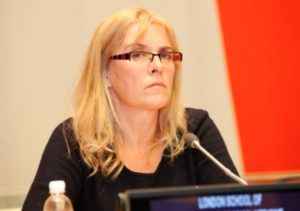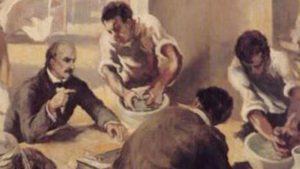コロナウイルスで世界中が苦しめられている現在、改めて手洗いを始めとする基礎的な衛生観念や習慣がいかに重要かが分かります。
実は1800年代に、手洗いをひとつのメッセージとして、衛生観念を人々に植え付けた人物がいました。
今回はその人について語っています。
In this programme we’ll be the discussing the importance of handwashing in the prevention of germs and viruses. And we’ll start off by meeting the first person to realise that keeping hands clean can really help prevent diseases being passed on.
このプログラムでは、細菌やウイルスの防止での手洗いの重要性について論じます。 まず人に会ったら手を清潔に保つことが病気の伝染を防ぐのに本当に役立つことを理解することからすべてが始まるのです。
What’s for sure is that Ignaz Semmelweiss was a hero to Val Curtis, a director at the London School of Hygiene and Tropical Medicine. Here she is talking to BBC Radio 4’s Science Stories:
確かなことは、現在ロンドン衛生熱帯医学校でディレクターを努めるヴァル・カーティスにとってイグナズ・ゼンメルワイスこそが英雄だったことです。 彼女はBBC Radio 4のサイエンスストーリーに出演して、こう話しています。
 Val Curtis, Director, London School of Hygiene and Tropical Medicine
Val Curtis, Director, London School of Hygiene and Tropical Medicine
Semmelweiss is kind of my patron saint. Handwashing has been my life for the last thirty years working on trying to improve hygiene, mostly in developing countries and he was really the first to identify the importance of keeping hands clean in the prevention of the transmission of infection. And since the beginning of my career working in public health I’ve been trying to understand how diseases get spread and what the best way of preventing it is, and handwashing jumped out as being the most important means of preventing infections, particularly in developing countries.
ヴァル・カーティス、ロンドン衛生熱帯医学校ディレクター
ゼンメルワイスは私の守護聖人とも言うべき人です。私にとって「手洗い」は過去30年間ライフワークであり、そのほとんどを発展途上国での衛生状態の改善のために捧げてきました。それを教えてくれたのが彼で、感染の伝染を防ぐために手を清潔に保つことがいかに重要であるかを最初に認識した人物です。私自身、公衆衛生でのキャリアの初めから、病気がどのように拡大し、それを防ぐ最善の方法が何であるかを理解するために努力を続けてきました。特に開発途上国では、感染を防ぐ最も重要な手段が手洗いであり、そのことが強いインパクトを持っているのです 。
 Ignaz Philipp Semmelweis Hungarian: Semmelweis Ignác Fülöp (1 July 1818 – 13 August 1865) was a Hungarian physician and scientist, now known as an early pioneer of antiseptic procedures. Described as the “saviour of mothers”, Semmelweis discovered that the incidence of puerperal fever (also known as “childbed fever”) could be drastically cut by the use of hand disinfection in obstetrical clinics.
Ignaz Philipp Semmelweis Hungarian: Semmelweis Ignác Fülöp (1 July 1818 – 13 August 1865) was a Hungarian physician and scientist, now known as an early pioneer of antiseptic procedures. Described as the “saviour of mothers”, Semmelweis discovered that the incidence of puerperal fever (also known as “childbed fever”) could be drastically cut by the use of hand disinfection in obstetrical clinics.
イグナズ・ゼンメルワイス(1818年7月1日-1865年8月13日)は、ハンガリーの医師および科学者であり、消毒手順の初期のパイオニアとして知られています。「母親の救世主」と称されたゼンメルワイスは、産科クリニックで手指消毒を行うことにより、産褥熱の発生率を大幅に削減できることを発見しました。
Val’s work is all about improving hygiene – practices for maintaining health and preventing disease, especially through cleanliness.
ヴァルの仕事は衛生状態を改善することの全般です。特に、清潔さを通じての健康維持と病気予防の実践です。
And she was clearly influenced by the work of Dr Semmelweiss because she calls him her patron saint – a kind of guide and protector believed to give special help or inspiration.
彼女がゼンメルワイス博士の偉業に影響を受けたのは明らかです。博士が自分の守護聖人であり、特別な助けやインスピレーションを授けてくれると信じており、先導者であり、保護者と見なしているのです。
But Dr Semmelweiss is also a good example of science communication. Getting the message out so people understand the importance of hygiene is difficult. And ‘wash your hands’ jumped out – or made a strong impact – as a simple message to communicate. Here’s Val again:
しかし、博士の存在は科学コミュニケーションでの学ぶべき例でもあります。一般的に人々にメッセージだけで衛生の重要性を理解させるのは至難の業です。博士は、「手を洗う」ことを、伝えるべきシンプルなメッセージとして発出した(それによって強いインパクトを与えた)のです。再びヴァルが語ります。
Val Curtis, Director, London School of Hygiene and Tropical Medicine
It wasn’t until we wrote a paper in 2003 that showed the evidence that handwashing could save a million lives that actually people started to take it seriously and handwashing became a big important issueinternationally. So for me the lesson from Semmelweiss is: don’t scream and shout and accuse people of doing things wrongly but patiently get the data out there and tell your story in a positive way.
ヴァル・カーティス、ロンドン衛生熱帯医学校ディレクター
私たちが手洗いで100万人の命を救えるという証拠を示した論文を2003年に発表してから、実際に人々が手洗いを真剣に考えるようになり、手洗いが国際的に重要な問題になりました。だから私がゼンメルワイスから得た教訓は、金切り声を上げたり、叫んだり、間違っている人を非難したりするのではなく、根気よくデータを示して、ポジティブな方法で自分のストーリーを伝えていくことです。



最近のコメント